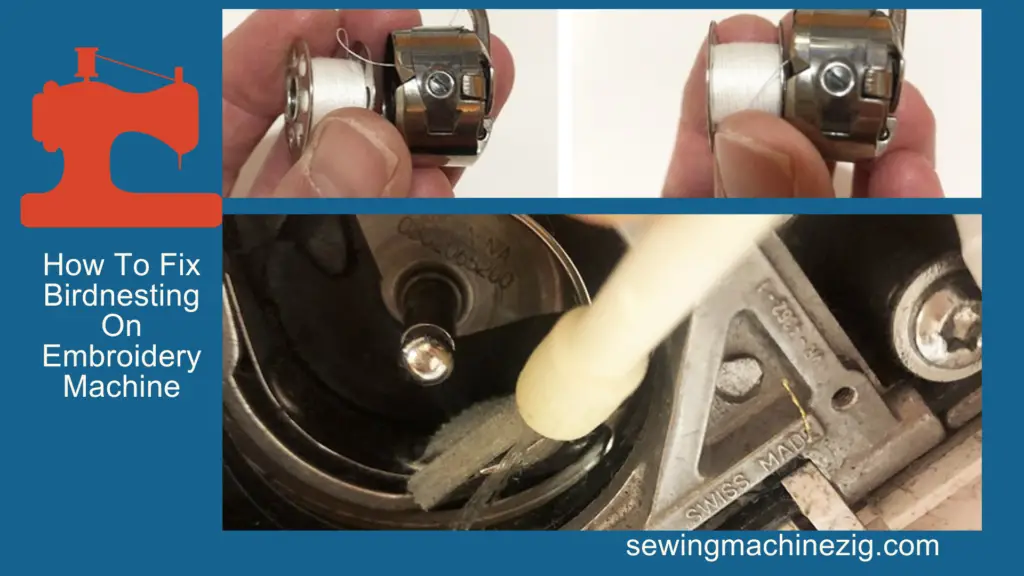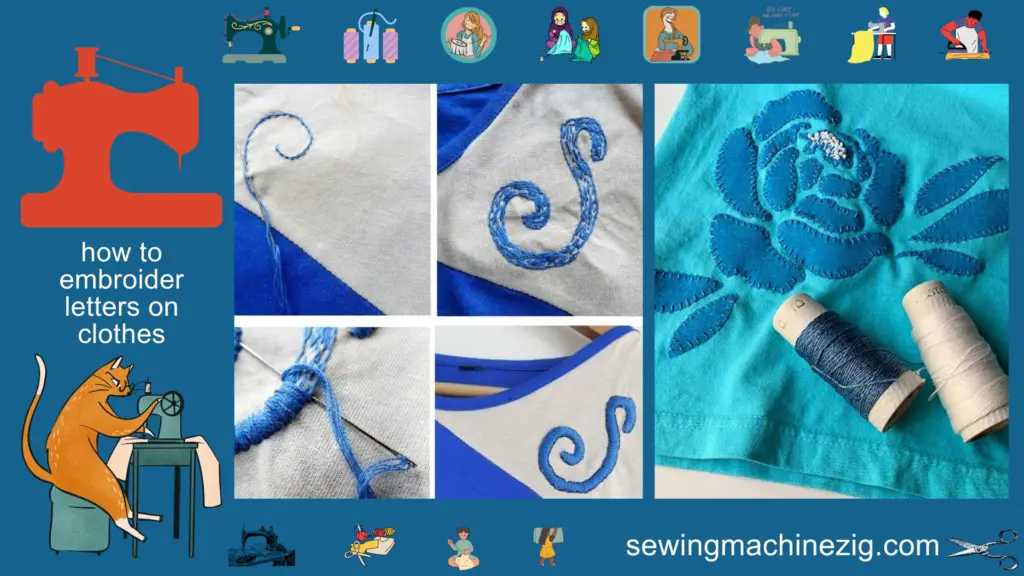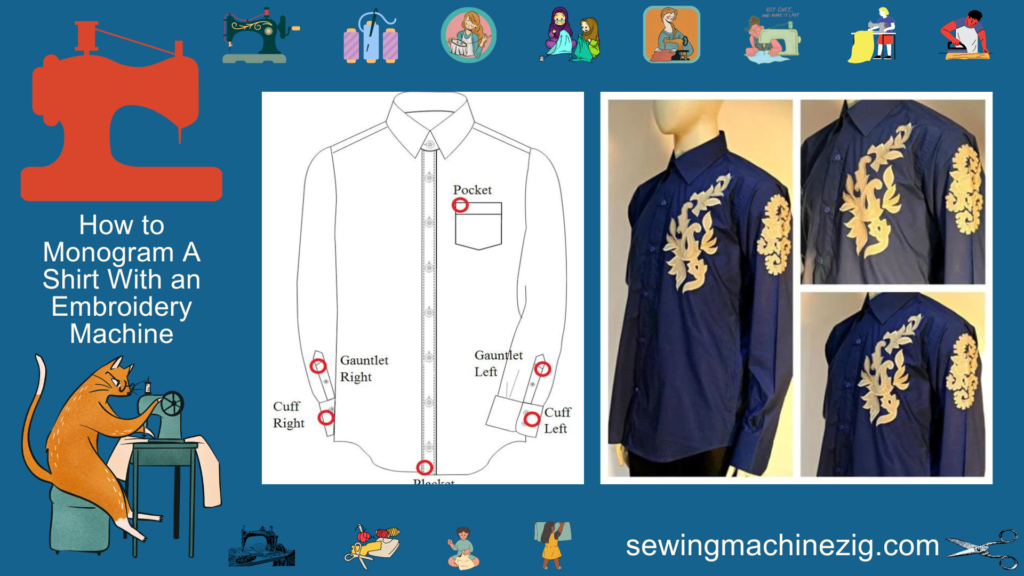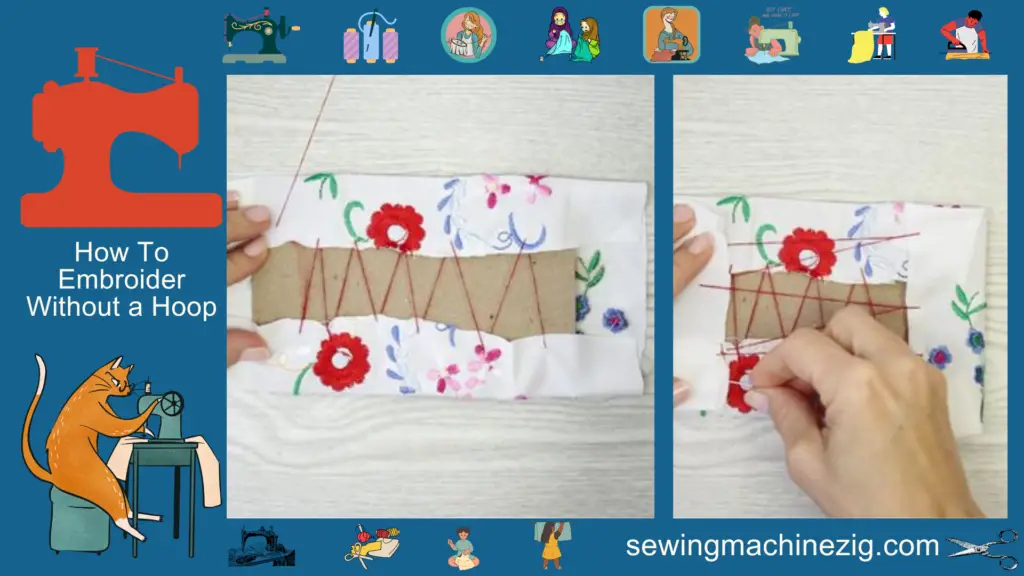
how to embroider without a hoop, Embroidery is a relaxing and fulfilling craft that allows you to unleash your creativity and express yourself through colorful and intricate designs. While embroidery hoops are commonly used to keep the fabric taut and in place, while stitching, not everyone has access to one or may prefer to work without it. Fortunately, there are several techniques you can use to embroider without a hoop, giving you more flexibility and creativity in your projects.
How to embroider without a hoop well embroidering without a hoop may seem daunting at first, but with a few simple tricks and techniques, you can achieve beautiful and professional-looking results. Whether you’re a beginner or an experienced embroiderer, learning how to work without a hoop can be a useful skill to have in your toolbox.
How To Embroider A Hat Without A Hat Hoop
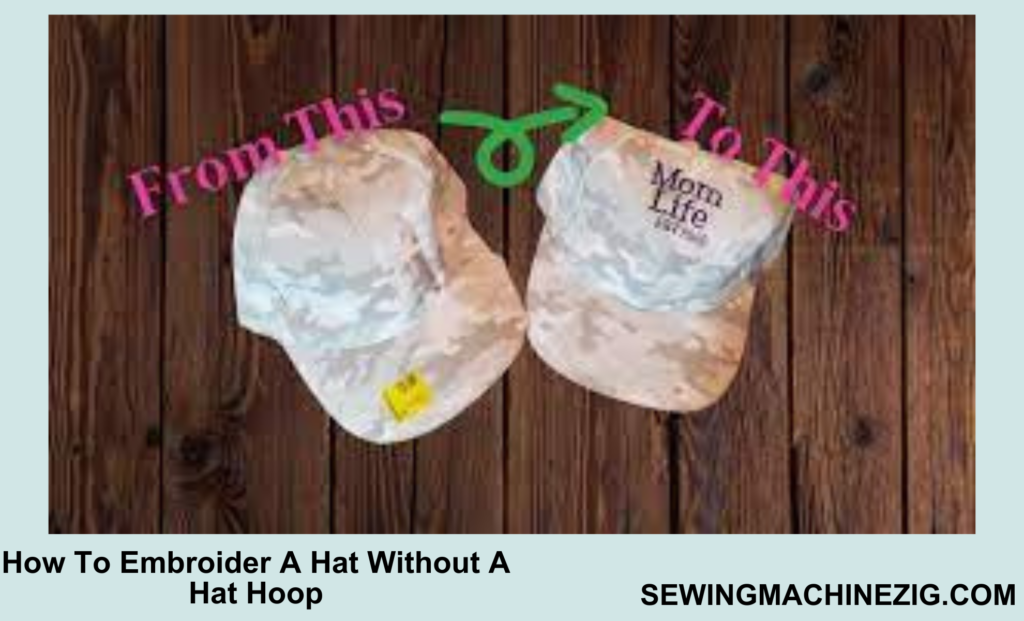
Embroidering a hat can be a fun and creative way to personalize your headwear and add a unique touch to your style. However, embroidering a hat without a hat hoop can seem like a challenging task. A hat hoop is a specially designed embroidery hoop that fits the curved shape of a hat, allowing you to keep the fabric taut and in place while stitching. But if you don’t have a hat hoop or prefer not to use one, don’t worry! There are several techniques and tips you can use to embroider a hat without a hat hoop.
In this article, we’ll explore some of the methods on how to embroider without a hoop you can on a hat, so you can get started on your next hat embroidery project with confidence.
Materials:
- A Hat (Made Of A Sturdy Fabric Such As Denim, Twill, Or Canvas)
- Embroidery Floss Or Thread
- Embroidery Needle
- Embroidery Design Or Pattern
- Fabric Marker Or Chalk
- Scissors
- Stabilizer (Optional)
Step-By-Step Guide:
Step 1. Choose Your Hat:
Select a hat made of a sturdy fabric such as denim, twill, or canvas. Avoid hats made of flimsy or stretchy material, as they may be difficult to embroider without a hoop.
Example: For this project, we will be embroidering a design onto a denim baseball cap. Leave at least 1 inch of space from the edge of the hat on all sides to ensure that your embroidery does not interfere with the fit of the hat.
Step 2. Choose Your Design:
Select an embroidery design or pattern that will fit the size and shape of your hat. You can either draw your design directly onto the hat using a fabric marker or chalk or transfer it onto the hat using a transfer pencil or iron-on transfer paper.
Example: For this project, we will be embroidering a simple flower design onto the front of the baseball cap. Leave at least 2 inches of space above the brim of the hat to ensure that your design is visible and not hidden when the hat is worn.
Step 3. Prepare Your Needle And Thread:
Thread your embroidery needle with a length of embroidery floss or thread that is long enough to complete your design without having to rethread your needle too often.
Example: We will be using a string of bright yellow embroidery floss for our flower design. Leave at least 2 inches of thread at the end of your needle to ensure that you have enough thread to complete your design without having to rethread your needle too often.
Step 4. Use A Stabilizer (Optional):
If you’re having trouble keeping your hat fabric taut while embroidering, you can use a stabilizer. Simply cut a piece of stabilizer to fit the size of your design and place it behind the hat fabric.
Example: We won’t be using a stabilizer for this project. Leave at least 1 inch of space between the stabilizer and the edge of the hat to ensure that your embroidery does not interfere with the fit of the hat.
Step 5. Begin Embroidering:
Start stitching your design onto the hat fabric, working from the center of your design outward. Use a combination of small stitches and long stitches to create texture and dimension.
Example: We will be using a combination of satin stitches, French knots, and stem stitches to create our floral design. Leave at least 1/4 inch of space between each stitch to ensure that your design is neat and tidy.
Step 6. Keep The Fabric Taut:
As you embroider, use your non-dominant hand to hold the hat fabric taut while you stitch. You can also pull the hat fabric taut by hand before starting each stitch.
Example: We will be using our left hand to hold the hat fabric taut while we stitch with our right hand. Leave at least 1/2 inch of space between your left hand and the edge of the hat to ensure that you have enough space to hold the hat fabric taut.
Step 7. Trim Excess Thread:
Once you’ve completed your design, use scissors to carefully trim any excess thread from the back of the hat.
Example: We will trim the excess yellow thread from the back of our flower design. Leave at least 1/4 inch of thread on the back of your embroidery to ensure that your design is secure and does not unravel.
Step 8. Enjoy Your Embroidered Hat:
Your embroidered hat is now complete! I hope now you learn how to embroider without a hoop. Wear it with pride and show off
How To Embroider Letters Without A Hoop
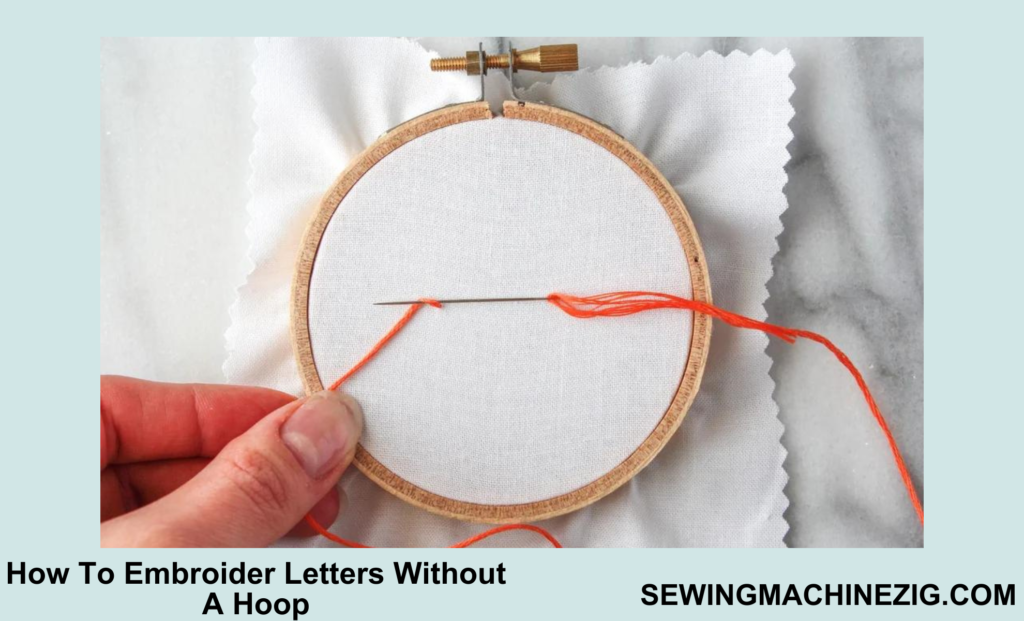
An embroidery is an art form that has been around for centuries, and it’s no surprise that it continues to be popular today. Embroidering letters onto fabric is a great way to personalize clothing, home decor, and gifts. However, not everyone has a hoop available to use for embroidery, and the idea of how to embroider without a hoop can be intimidating. But fear not! It is possible to embroider letters without a hoop, and with a little practice, you can achieve beautiful results.
Embroidering without a hoop requires a steady hand and some patience. It’s important to use the right materials and follow the proper techniques to ensure your stitches stay in place and your letters look neat and tidy.
In this article, we will guide you through the materials needed and step-by-step instructions for how to embroider without a hoop. We will also provide tips and tricks to help you get the best results possible. Whether you’re a seasoned embroidery pro or a beginner, this guide will help you achieve stunning embroidery designs without the use of a hoop.
Materials needed:
- Embroidery floss
- Embroidery needle
- Fabric
- Carbon paper or transfer pen
- Small embroidery hoop (optional)
- Scissors
Step-by-Step Guide:
Step 1: Choose your design
Choose the font and size of the letters you want to embroider. For this example, we will embroider the word “LOVE” in a script font. Leave at least 1 inch of space from the left and right edges of the fabric.
Step 2: Thread your needle
Cut a length of embroidery floss to your desired length and thread the needle. Use all six strands of the floss for a bold line.
Step 3: Start your first stitch
Tie a knot at the end of your floss and start your first stitch at the top of the first letter “L”. Use a backstitch for this example.
Step 4: Continue stitching
Continue stitching the first letter “L”, following the lines of the design. Keep your stitches tight and even. Leave at least 1/2 inch of space between the left edge of the fabric and the first stitch.
Step 5: Finish the first letter
When you reach the bottom of the first letter “L”, tie off your thread and cut the excess. Leave at least 1/2 inch of space between the right edge of the first letter and the left edge of the second letter.
Step 6: Move on to the next letter
Repeat steps 3-5 for the rest of the letters in the word “LOVE”. Make sure to leave enough space between each letter to create a clean and legible design.
Step 7: Optional: Use a small embroidery hoop
If you find it difficult to keep your fabric taut without a hoop, you can use a small embroidery hoop to help. Place the fabric in the hoop and tighten the screw to hold it in place. Make sure not to over-tighten the hoop, as it can stretch or distort the fabric.
Step 8: Finish your embroidery
When you’ve finished embroidering all the letters, tie off your thread and trim the excess. You can leave the embroidery as is or wash it to remove any remaining transfer marks.
In this example, we left at least 1 inch of space from the left and right edges of the fabric and at least 1/2 inch of space between each letter to create a balanced design. These measurements may vary depending on the size of your letters and the thickness of your floss. Make sure to adjust accordingly and experiment with different designs to find what works best for you. It’s also related to how to embroider without a hoop.
Do You Need An Embroidery Hoop To Embroider?
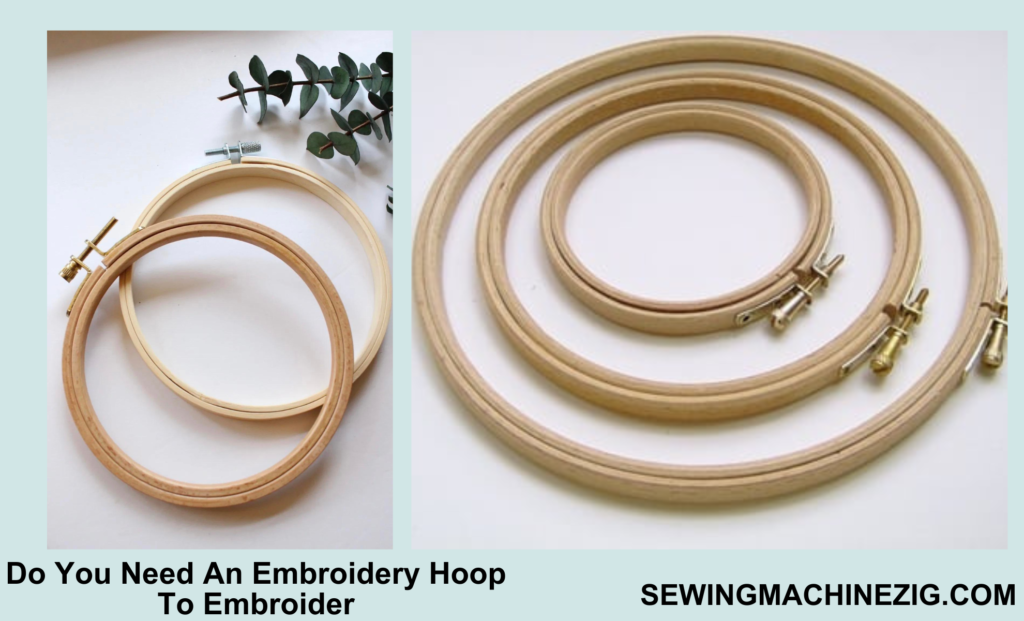
“how to embroider without a hoop” it’s another part is Embroidery hoops which are commonly used by embroiderers to keep the fabric taut and prevent it from bunching or wrinkling while stitching. The hoop consists of two circular frames, one of which is slightly smaller than the other, that fit together and hold the fabric securely in place. The fabric is placed between the two hoops, and the outer hoop is tightened to stretch the fabric taut. This creates a stable surface on which to work and ensures that the stitches are uniform and even.
However, how to embroider without a hoop does require some skill and technique. Without the support of a hoop, the fabric can move and shift while stitching, which can lead to uneven stitches or puckering. Embroiderers working without a hoop must learn to keep the fabric taut and stable by holding it with their non-dominant hand or using a stabilizer.
Ultimately, the decision to use a hoop or not depends on the embroiderer’s preference and the requirements of the project. Some embroiderers may choose to use a hoop for larger projects or when using delicate fabrics, while others may prefer to work without a hoop for more flexibility and control. Regardless of the method used, with practice and skill, beautiful embroidery can be achieved with or without an embroidery hoop. It’s another part of how to embroider without a hoop.
How Do You Do Back Embroidery Without Hoops
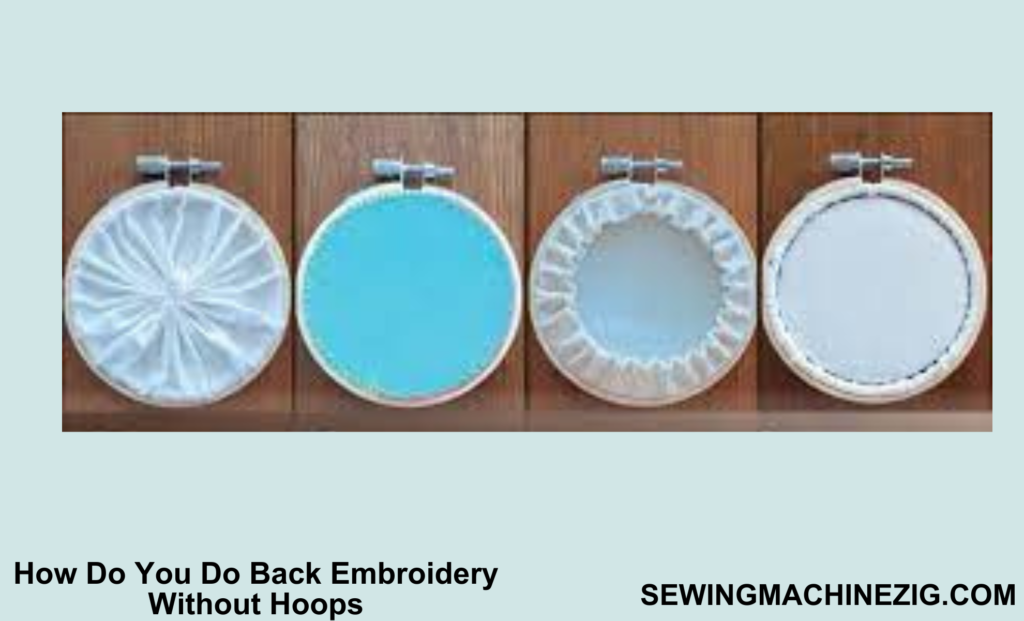
Back embroidery is a popular embroidery technique that creates a beautifully textured effect on the fabric. While many embroiderers use hoops to keep the fabric taut and stable while working, it is also possible to do back embroidery without the use of a hoop.
This method can be useful for those who prefer to work with more flexibility or for embroidering on fabrics that are difficult to fit into a hoop. However, it does require some skill and technique to ensure even stitches and prevent puckering or bunching of the fabric. In this article, we will provide a step-by-step guide on how to embroider without a hoop to do back embroidery without the use of a hoop.
Materials:
- Fabric
- Embroidery floss or thread
- Embroidery needle
- Stabilizer (optional)
Step-by-Step Guide:
Step 1: Choose your design and transfer it onto the fabric using a transfer pencil, tracing paper, or another transfer method.
Step 2: Cut a length of embroidery floss or thread, and knot one end.
Step 3: Bring the needle up through the fabric from the back, leaving a small tail of thread.
Step 4: Insert the needle back down into the fabric a short distance away, creating a straight stitch.
Step 5: Bring the needle up through the fabric slightly to the right of the first stitch and insert it back down into the fabric slightly to the left of the first stitch, creating a diagonal stitch.
Step 6: Repeat steps 4 and 5 to create a row of backstitches.
Step 7: Continue stitching rows of backstitches until the design is complete.
Step 8: Knot the end of the thread and weave it back into the stitches to secure it.
Example: To embroider a simple straight line, start by bringing the needle up through the fabric from the back, leaving a small tail of thread.
Insert the needle back down into the fabric 1/4 inch to the right of the starting point, and bring it up through the fabric again 1/4 inch to the right of the first stitch. Continue stitching in this manner, making stitches that are approximately 1/4 inch in length, until the line is complete. Knot the end of the thread and weave it back into the stitches to secure it. ( how to embroider without a hoop )
What To Use Instead Of Embroidery Hoop
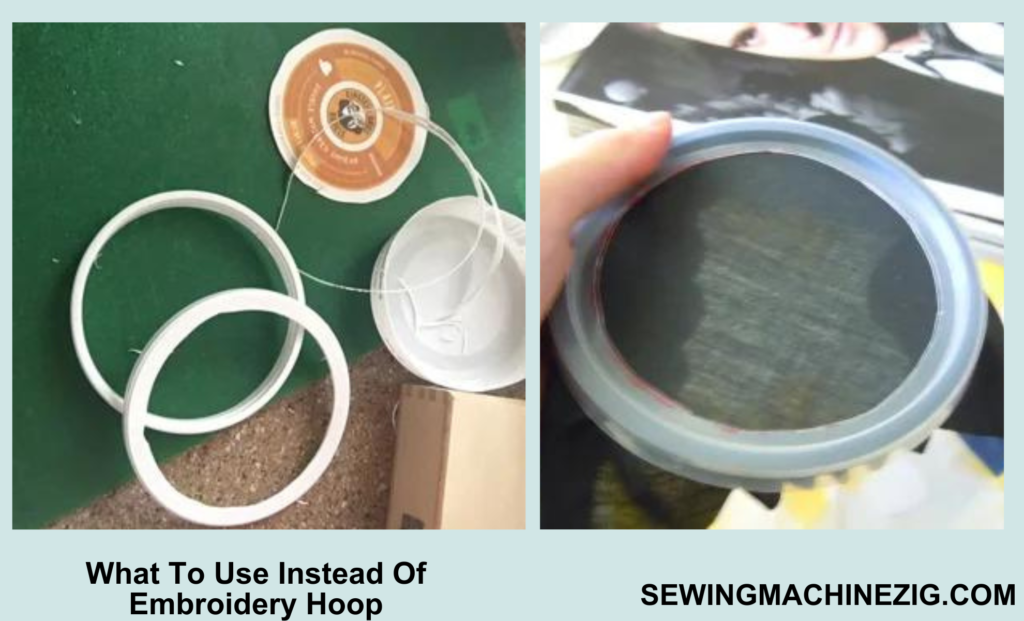
If you don’t have an embroidery hoop, there are several alternatives that you can use to hold your fabric taut and stable while embroidering. Here are a few options:
1. Embroidery Stand:
An embroidery stand is a freestanding frame that holds your fabric taut, leaving your hands free to do the embroidery work.
2. Q-Snap Frame:
A Q-Snap frame is similar to an embroidery hoop but has a unique shape that allows it to hold your fabric more securely. It consists of four interlocking plastic tubes that can be adjusted to fit the size of your fabric.
3. Scroll Frame:
A scroll frame is a two-piece frame that holds your fabric between two wooden dowels. The dowels can be tightened or loosened to adjust the tension on the fabric.
4. Stretching the Fabric:
You can stretch your fabric over a flat surface, such as a table, and secure it in place with tape or clips. This method requires some skill and practice to ensure that the fabric is stretched evenly and taut.
5. Stabilizer:
If your fabric is thin or delicate, you can use a stabilizer to add stability and structure to the fabric while you embroider. Stabilizers come in various types and can be ironed onto the back of the fabric or placed underneath it.
Remember, the choice of an alternative method depends on personal preference and the type of fabric you are working with.
Conclusion
Embroidering without a hoop is a convenient option for those who may not have one or prefer not to use one. While using a hoop helps to keep the fabric taut and prevents puckering, there are several alternatives that can be used to achieve the same result. By using stabilizers, embroidery stands, Q-snap frames, scroll frames, or stretching the fabric over a flat surface, you can successfully complete your embroidery project without a hoop.
It’s important to note that how to embroider without a hoop may require more practice and skill to achieve consistent tension on the fabric. However, with the right technique and tools, embroidering without a hoop can result in beautiful and professional-looking embroidery. So don’t let the lack of a hoop hold you back from your embroidery projects, and feel free to experiment with the alternatives available to you. now you are fully expert in “how to embroider without a hoop“
FAQs:
Q 1: Is it possible to embroider without a hoop?
A: Yes, it is possible to embroider without a hoop using a variety of methods such as using stabilizers, embroidery stands, Q-snap frames, scroll frames, or stretching the fabric over a flat surface.
Q 2: Why would someone choose to embroider without a hoop?
A: Some people may choose to embroider without a hoop for various reasons such as not having a hoop available, finding it uncomfortable to use, or preferring to work with a larger piece of fabric.
Q 3: What are the disadvantages of embroidering without a hoop?
A: Embroidering without a hoop may make it more difficult to maintain consistent tension on the fabric, which can lead to puckering or uneven stitches. It may also require more skill and practice to achieve professional-looking results.Now you know the importance of how to embroider without a hoop.
Q 4: Can any fabric be used for embroidering without a hoop?
A: Yes, any fabric can be used for embroidering without a hoop, but it’s important to choose a fabric that can hold its shape and maintain consistent tension without a hoop. Stabilizers can also be used to help reinforce the fabric and prevent distortion.
Q 5: Do I need special tools to embroider without a hoop?
A: While special tools such as stabilizers, embroidery stands, Q-snap frames, and scroll frames can be helpful, they are not necessarily required. Stretching the fabric over a flat surface is a simple and effective alternative that only requires a few basic materials.
Q 6: How do I keep my fabric taut without a hoop?
A: To keep the fabric taut without a hoop, you can use a variety of methods such as basting the fabric to a stabilizer, using an embroidery stand, or stretching the fabric over a flat surface and securing it with tape or clips.
Q 7: Can I use the same embroidery stitches when embroidering without a hoop?
A: Yes, the same embroidery stitches can be used when embroidering without a hoop, but it’s important to pay extra attention to maintaining consistent tension on the fabric to prevent puckering or uneven stitches. Now you know the importance of how to embroider without a hoop.

